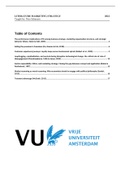LITERATURE MARKETING STRATEGY 2022
Taught by: Nico Schauern
Table of Contents
The performance implications of fit among business strategy, marketing organization structure, and strategic
behavior (Olson, Slater & Hult, 2005).................................................................................................................. 2
Selling the premium in freemium (Gu, Kannan & Ma, 2018).................................................................................6
Customer experience journeys: Loyalty loops versus involvement spirals (Siebert et al., 2020)............................9
Leapfrogging, cannibalization, and survival during disruptive technological change: the critical role of rate of
disengagement (Chandrasekaran, Tellis & James, 2022).....................................................................................12
Social responsibility: Ethics, and marketing strategy: Closing the gap between concept and application (Robin &
Reidenbach, 1987)............................................................................................................................................. 16
Market reasoning as moral reasoning: Why economists should re-engage with political philosophy (Sandel,
2013)................................................................................................................................................................ 16
Transient advantage (McGrath, 2013)................................................................................................................ 17
1
,The performance implications of fit among business strategy, marketing
organization structure, and strategic behavior (Olson, Slater & Hult,
2005)
Research proposal: the relationship between marketing organization structure and strategic
behavior and firm performance is moderated by the business strategy a firm adopts.
This is fundamental for competitive advantage and the sustainability of that advantage.
Business strategy
Business strategy: how firms compete in an industry or market.
There are 2 dominant frameworks of business strategy:
1) Miles and Snow (1978): addresses the alternative ways that organizations define and
approach their product-market domains and construct structures and processes to achieve
competitive advantage in those domains. There are 4 archetypes to address the issues:
a. Prospectors continuously attempt to locate and exploit new product and market
opportunities.
H1: the highest-performing prospector firms have marketing organizations that are characterized
by a high number of specialists who operate in a decentralized, informal organization and who
place a greater emphasis on customer and innovation orientations. supported, there is also a
negative effect of competition orientation.
b. Analyzers occupy an intermediate position by cautiously following prospectors
into new product-market domains while protecting a stable set of products and
customers.
H2: the highest-performing analyzer firms have marketing organizations whose behaviors are
focused on customers and competitors. supported, there is also a negative effect of innovation
orientation.
2
, c. Defenders attempt to seal off a portion of the total market to create a stable set of
products and customers. There are low cost-defenders and differentiated
defenders.
H3: the highest-performing low-cost defender firms have marketing organizations that are
characterized by few marketing specialists; formal and centralized decision-making processes;
and a behavioral focus on internal operations, cost control, and competitors. partly supported,
there is a positive effect of internal/cost orientation and competitor orientation, but there is a
negative effect of innovation orientation, the impact of decentralization was positive.
H4: the highest-performing differentiated defender firms have marketing departments that are
characterized by a formal environment in which employees have considerable discretionary
authority (i.e., decentralized) and are primarily focused on customers. partly supported, there is a
positive effect of customer orientation and formalization on performance. However, contrary to
the prediction, decentralization, specialization, competitor orientation, innovation orientation,
internal/cost orientation, and the control variables were not significant.
d. Reactors do not have a consistent response to the entrepreneurial problem.
internal focus
2) Porter (1980): proposes that business strategy should be viewed as a product of how the
firm creates customer value compared with its competitors (i.e., differentiation or low
cost) and how it defines its scope of market coverage (i.e., focused or market wide).
external focus
Organizational structure
Organizational structure: coordinate work that has been divided into smaller tasks.
“How that coordination is achieved—by whom and with what—dictates what the organization
will look like.”
3 constructs:
1) Formalization: the degree to which formal rules and procedures govern decisions and
working relationships.
a. Highly formal procedures = ‘mechanistic”
b. Fewer formal procedures = ‘organic’. Horizontal and vertical communication
rapid awareness of and response to competitive and market change, more
effective information sharing, and reduced lag time between decision and action.
2) Centralization: whether decision authority is closely held by top managers or is
delegated to middle- and lower-level managers.
a. Centralized = implementation tends to be straightforward after the decision is
made, but fewer innovative ideas tend to be put forth.
b. Decentralized = a variety of views and ideas may emerge from different groups,
decision making and implementing a decision takes longer. Produce more new
ideas and changes.
3) Specialization: degree to which tasks and activities are divided in the organization and
the degree to which workers have control in conducting those tasks.
3




